Effects of Online Training on Employee Satisfaction: McDonald's Case Study
Info: 10880 words (44 pages) Dissertation
Published: 15th Dec 2021
Tagged: Employment
An investigation into how employee satisfaction has been affected by the move to online training at McDonald’s Isle of Man.
Abstract
eLearning is a new and exciting way to train employees through the use of online technologies. It allows employees to access information no matter where they are. With a lot of debate surrounding its effectiveness and the effect it has on employee satisfaction. This report investigates how the eLearning system at McDonald’s Isle of Man has impacted employees as well as their view on the current system. Past literature has been established to provide basis for the report and build a foundation for the questionnaire. The objective of the study was to analyse employees views and opinions on eLearning and the move to online training and establish a relationship between that and employee satisfaction.
1.0 Introduction
1.1 Purpose of Research
The purpose of this research is to analyse the move to online training conducted within McDonald’s Isle of Man. To determine whether the online system is effective in improving employee satisfaction. The collection of primary data through questionnaires will show whether the move to online training has been beneficial for employees as well as if it has been an effective tool in increasing employee motivation and performance, and if not, producing recommendations to improve motivation and performance of employees through the online training method.
1.2 Research Question
Has the move to online training at McDonald’s Isle of Man resulted in improved employee satisfaction?
1.3 Research Objectives
- To investigate why companies, train their employees and what the purpose and expected outcome of this training is.
- To critically assess McDonald’s Isle of Man’s (IOM) current objectives regarding training and development against previous years and discuss the future impact this may have.
- To critically evaluate the success of Mcdonald’s IOM’s improvements on T&D against their employee turnover and discuss whether this may have impacted the success of implementing new systems.
- To conduct a survey finding out how employees perceive the improvements and analysing the data to investigate whether it supports or challenges the hypothesis.
1.4 The Organisation
McDonald’s IOM is the only McDonald’s franchise on the island. The store employs over 70 people and is up to date following all new systems and procedures that have been created and introduced by the McDonald’s UK head office.

1.5 The online training system at McDonald’s IOM
The online training is separated into several modules for the different areas to work within the store as well as the different stations that employees may work on. All members of staff have access to this training as well as more modules being unlocked by the business manager if employees wish to progress through the different roles available.
1.6 Justification of Research
The online training system is a beneficial source of learning for employees as it can be accessed from anywhere. Training and Development plays an important role in job satisfaction for employees as it shows the opportunities provided to them and gives them the chance to develop a career. However, the eLearning system at McDonald’s Isle of Man may be arguably overwhelming and time consuming for employees having a demotivating effect.
1.7 Hypothesis
As an employee of McDonald’s IOM it has been noticed that in recent years that employee morale, motivation and performance have improved dramatically since the new training system was put in place. It may be hypothesised that it is other impacts that are improving these factors for employees such as pay rises. Furthermore, it may also be hypothesised that areas in the availability of the training for progression within roles needs to be improved. Finally, it is hypothesised that due to justification of literature that already exists as well as motivational theory along with existing training elements, the move to online training at McDonald’s IOM will have many elements that positively affect employee satisfaction.
2.0 Literature Review
2.1 Introduction to chapter
This chapter reviews existing and relevant literature to create plausible foundations for the research. Relating to research objective one.
2.2 Employee retention factors
A survey conducted on hourly paid fast food service employees within the UK found that the most important characteristics of their employment were: flexible working hours, hourly wage and introductory training. (DiPietro & Thozhur, 2007). The nature of work is a facet of job satisfaction that correlates with several of the big five psychological dimensions. The nature of work dimension seeks to find out for certain whether employees like or dislike their role. The implication for management is that if they are able to create cultures of support for employees, they will be able to reduce feelings of immense stress and reduce staff turnover. (Silva, 2006).
2.3 eLearning
Training is the systematic development of the knowledge, skills and attitudes required by an individual to perform adequately a given task or job. (Armstrong, 2018).
The internet has had a huge impact on society and created a new revolution in the 21st century where everything and everyone are going online. (Dentzel, 2018). The web is now more than an information search and social media feature but as well a learning tool that allows others ways to build their knowledge and share it with others. (IRMA, 2018).
The European commission describes eLearning as the use of the internet and new multimedia technologies to advance the quality of learning by providing access to resources and services, as well as enabling remote exchange and collaboration. (European, 2018). Employees are able to access online resources at any time, anywhere. (Ali, 2018).
eLearning provides food service operators with the rapidly deployable, efficient applications they desire. Sharing training information and knowledge through technology allows learners to individually process and absorb critical information faster than ever before, while decreasing overall training costs. Web-based programmes mean that problems start to be eliminated. Such as lack of time, managerial responsibility, inconsistent instruction, high cost and inconvenient delivery. (Biars, 2005).
2.4 Importance in Organisations
Within a fast-paced corporate world, training and development is a very necessary function. It is often one of the lowest priorities on an organisations list. Training allows employees to acquire new skills, improve existing skills, perform better, increase productivity and be better leaders. (Times, 2015). Training and development can be very easily overlooked in organisations, to prevent high employee turnover employers should be transparent about what they offer and consult with the current and future workforce on the employee value proposition. (CIPD, 2019).
Many employees enter a job role with the hope of developing a career out of it. Opportunities for advancement are essential to employee retention and performance. However, if these prospects only exist in theory, then employees will not feel that they are valued and interested in the organisation. (Speer, 2017).
A survey conducted by the Conference Board showed that happiness at work is continuing to improve with 51% of U.S. employees saying that they feel satisfied and engaged. However, despite of this only 37.5% of the employees questioned felt content with their potential for growth. (Montanez, 2018). Employees who perceive that they have the opportunity to develop new skills are more satisfied with their jobs, more loyal and more likely to stay with the organisation. (Costen & Salazar, 2011).
2.5 Impact on business performance
Business performance is derived from how well the organisation is being managed and the value that is being delivered for customers. (Moulin, 2007). Highly trained employees within fast food that have a great understanding of their role will provide a better customer service level that increases the businesses reputation. Furthermore, the management of the organisation will have an impact on what training is offered to employees and the opportunities that employees will feel comfortable taking. (Davis, 2013).
Several studies show a strong correlation between the level of productivity and creativity of employees with the level of employee satisfaction. Employees who are satisfied tend to be more productive at work and produce innovative ideas. (Purba, 2017).
2.6 Business objectives with Training and Development
The training of employees should be based on the objectives of the organisation. A study by (Hussey, 1985) concluded that UK companies training rarely aligned with business objectives and the employee relates the training to promotion or individual skills rather than trying to benefit the company as well. Only seeing the benefits for themselves. Skinner believed that T&D programs should align with the organisation’s objectives as well as a positive outcome being expected. (Thomson, 1998). An objective to lower employee turnover may be a possibility if the T&D of employees is improved, making them feel looked after and wanted by the business.
Eaglen et all (2000) conducted a study on McDonald’s and identified a systematic approach to training as a way to achieve strategic objectives. Training is in direct benefit to the organisation as identified by Burden and Proctor (2000) that a firm’s ability to learn faster than its competitors may be its only sustainable advantage. (Khawaja, 2012).
2.7 Psychological Contract
Psychological contract theory maintains that employees form beliefs about the resources they owe to their employer and those that are owed to them in return by the organisation that they work for. These mutual obligations allow employees to better adapt to organisational life and thereby reduce the uncertainties that lead to stress and voluntary turnover. (Karagonlar, Eisenberger, & Aselage, 2015).
Training and development is central to the psychological contract in several ways:
- It ensures employees have skills to engage in the process of maintaining or rebuilding the psychological contract after major change.
- It provides valuable currency in the exchange relationship.
- It promotes management understanding of the dynamics of the psychological contract, enabling it to be successfully managed and maintained in times of change. (Garrow, 2004).
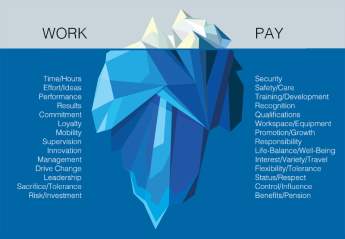
Source: (Hall, 1977).
The iceberg model links to the psychological contract. Showing the sometimes unthought of needs of employees and employers and outlining what is just on the surface within employment. It is an unwritten contract that is expected to be met from both sides.
If the elements shown under the surface of the iceberg model are ignored it can have a detrimental impact on the organisation’s objectives to retain staff long term as well as employee satisfaction.
There is a theme appearing that having set objectives corresponding with training programmes already in place will result in achievement of these objectives. Armstrong (2009) suggested that training may refer to giving employees the right skills, knowledge and abilities. Having an aim to build the organisations capabilities as well as increasing performance.
2.8 Culture of the organisation
The culture of an organisation is really important for learning and development. Promoting innovation and improvement from employees will increase productivity. Kaizen is one of the core principles of the Toyota Production system, a quest for continuous improvement and a single word that sums up Toyota’s ‘Always a Better Way’ slogan. (Toyota, 2013). If businesses don’t promote a culture that strives for better than employee motivation will decrease. This is because employees will feel that they have little opportunity and that they go into work and do the same job every day without anything else to do and will be less productive with their time. They also won’t want to share their ideas to better the current production or layout which could increase profitability.
2.9 McDonaldisation of society
McDonaldisation is the process by which principles of fast food restaurants have come to dominate virtually every aspect of society. The building block for McDonaldisation comes from the concept of rationalisation. Which is the process of replacing traditional and emotional thought with reason and efficiency. (Ritzer, 2014).
McDonald’s training is standardised. Individual differences are subsumed to the point that everyone is treated the same. The efficiency, control, predictability and calculability of McDonaldisation are reflected in the intense training and supervision of new recruits. Rigid, clear training and career pathways enable successful global reproduction of the McDonald’s model. In several OECD countries, McDonald’s is a nationally registered training organisation where credentials are transferrable to other institutions. (Nadolny & Ryan, 2015).
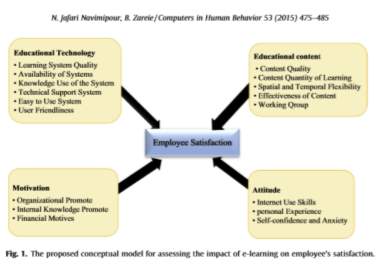
This model proposes how businesses can look at different aspects of eLearning on employee satisfaction.
2.10 Systems
Four general categories of eLearning systems were identified by Samgra, Vlachopoulos, and Cabrera (2012): Technology driven, delivery system orientated, communication orientated and educational paradigm orientated. Most definitions of eLearning have focused on the delivery of a learning service through electronic media. (Ahmed, Steel, & Soar, 2016).
At the start of the 21st century, due to substantial growth in electronic retailing, a new direction in service quality appeared. The focus of this trend was online service quality. E-service quality is a critical determinant of the success or failure of electronic commerce. (Ahmed, Steel, & Soar, 2016).
2.11 Management role in Training and Development
Daniels (2006) said that managers would benefit in developing an individual relationship with employees to ensure that they are being as fair as they can possibly be. As they are fully aware of the nature of work that person does and how hard they have worked. (Gomes, 2014).
2.12 eLearning as a training tool
eLearning is not intended to substitute the old-style classroom setting, but to provide new opportunities for contact and communication. (Masrom, 2007). With the speedy development of information, society and wide spread of life-long learning. The needs for knowledge are growing dramatically. (Zhang & Yuhao, 2012).
eLearning is nonlinear i.e. Learners determine how, what and when they access information. It is a vibrant process- altered, custom-made and tailored on demand in response to learner and environmental variables. It is available on demand and just in time. The learner controls their own communication with the content and presentation. (Smith & Erica, 2007).
2.13 Employee Satisfaction
Vroom (1964) said that job satisfaction is an orientation of emotions the employees towards the role they are performing at the work place. Job satisfaction is the essential component for employee motivation and encouragement towards better performance.
Baah and Amoako (2011) described that the motivational factors (the nature of work, the sense of achievement from their work, the recognition, the responsibility that is granted to them, and opportunities for personal growth and advancement) helps employees to find their worth with respect to value given to them by organization. Further, this can increase motivational level of employees which will ultimately raise internal happiness of employees and that the internal happiness will cause satisfaction. (Raziqa, 2014).
3.0 Methodology
3.1 Introduction
This chapter is based around the research onion, through which the methodological standpoint of this study is derived around. The reasons behind this approach will be given, along with why other potential approaches were not chosen. By understanding the methodology, the research design and methods that were used are best placed to achieve the requirements for the investigation. Furthermore, ethical considerations are addressed.

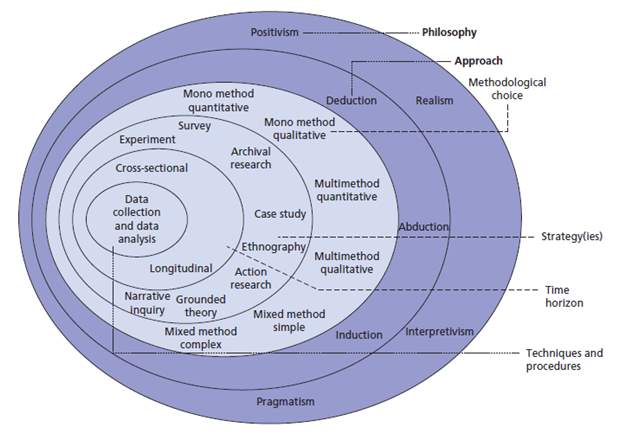
Retrieved from Saunders, Lewis and Thornhill (2012, p.128).
3.2 Research Philosophy
To be able to answer the research question effectively and accurately, a highly structured approach to methodology was taken. This provides justification for the positivist philosophical approach used. The study is an investigation of how employees feel about their training and development opportunities and what improvements they feel can be made. A positivist approach has been taken as a hypothesis has been created to approve or disprove. (Mack, 2018). Furthermore, existing theory was used to develop the hypothesis as well as the researchers own observations throughout employment within the business used. (Saunders, Lewis, & Thornhill, 2016).
3.2.1 Rejected Ideas
An interpretive philosophy could have been used due to its focus on humans and it being well suited to the employee aspect of the organisation. Through the term ‘social actors’ meaning that as humans we play a part on the stage of human life. We play a part which we interpret in a certain way as well as interpreting the social roles of others in accordance with our own set of meaning. However, this theory was rejected as they view the world of business and management as far too complex to be conveyed by existing theory. (Saunders, Lewis, & Thornhill, 2016).
3.3 Research Approach
A deductive approach was used to test and develop the hypothesis proposed. Initially, by reviewing the theory of employee satisfaction and what impact eLearning has had in the new era, as shown in the literature review. The examination of theory as well as real life observations helped form the hypothesis which was tested after the collection and analysis of both primary and secondary data. This approach can be linked to quantitative data which is mainly generated through questionnaires. (Saunders, Lewis, & Thornhill, 2016). However, qualitative data can be used to provide more understanding and knowledge for the investigation.
Furthermore, investigations into McDonald’s own viewpoint survey meant that the researcher could further their knowledge on the employees’ perspective of their job role as well as job satisfaction in the organisation.
3.3.1 Rejected Ideas
An inductive approach would not be appropriate for this research as the key theory and literature surrounding employee satisfaction and online training informed the questions for the questionnaire that was produced, which were made to test the hypothesis and answering the research objectives.
3.4 Research Method Choices
A mono method was appropriate for this research, as a questionnaire was used to generate data. Both qualitative and quantitative data was generated using both open and closed questions. Saunders et al (2016) said that research undertaken in business organisations often uses a mix of qualitative and quantitative questions to gain richer data that is valuable to answering the research question and objective. The questionnaire is predominantly quantitative, therefore supporting the mono method approach.
3.4.1 Rejected Ideas
A multi method approach was rejected because it would have been too time consuming for the researcher. Furthermore, all the relevant data that was needed was collected through the questionnaire that was conducted. Which included questions that provided perceptions, opinions and statistics that were needed to answer the research question.
3.5 Research Strategy
Survey Based Questionnaire
A survey is often associated with a deductive approach, showing the reasoning behind the use for this research. (Saunders, Lewis, & Thornhill, 2016). Questionnaires are useful for accessing small or large samples, ensuring anonymity to all participants which was relevant to the research conducted. Questionnaires are also an effective tool in measuring the levels of motivation and satisfaction as well as looking at the effectiveness of training and development. Which supports the use of this for investigating employees’ opinions. (Fletcher, 2004).
Questionnaires are one of the most widely used data collection methods as each person is asked to answer the same questions in the exact same order, while allowing researchers to access large samples and gather valuable information through open and closed questions while generating richer data. Self-constructed questionnaires are cheaper and quicker to administer, therefore saving time to analyse results. (Saunders, Lewis, & Thornhill, 2012).
3.5.1 Rejected Ideas
Interviews were rejected for this research project as they are too time consuming and McDonald’s Isle of Man has over 70 employees, so it would have been difficult to interview enough people. Especially with shift work and people working different hours. It also would have been difficult to get enough people to do a group interview as people have different days off and during the shifts it would have been too busy to get a group together.
Furthermore, if employees felt that the manager was going to find out their answers from the interview and did not believe it was anonymous it would affect the reliability of the results as they may believe they can not be truthful.
3.6 Time Horizons
The time horizon was cross-sectional as it employed the survey strategy of gathering data of perceptions at one particular time. (Saunders, Lewis, & Thornhill, 2016).
3.7 Data Collection and Analysis
The purpose of this research is to find out whether the move to online training at McDonald’s Isle of Man has resulted in improved employee satisfaction. Evaluative studies are used to measure the effectiveness of an organisational process or strategy. (Saunders, Lewis, & Thornhill, 2016).
- A review of the existing literature surrounding employee satisfaction was conducted as well as an investigation to eLearning and how it impacts an organisation.
- A questionnaire was constructed surrounding the appropriate literature to ensure all objectives were being met as well as making sure the research question was being answered.
- The questionnaire was sent to 30 employees of the store that would not have difficulty answering the questions due to language barriers and translations being required as some employees speak very little English.
- To overcome any potential ethical issues. The responses were completely anonymous so that employees did not feel as though their job would be affected when the organisation read over the research project.
- The time limit for responses was the 10th July however, with it being a busy time of year at the store many people found it hard to find time to complete the questionnaire with being tired after work as well as working long hours. The last response was sent on the 10th August.
- Within the next chapter, it will show that all questionnaire data was analysed using graphs and pie charts as well as responses to open ended questionnaires being shown. This formed the analysis leading on to the conclusions and recommendations.
- The use of secondary research was also done as McDonald’s have their own employee satisfaction survey which I was given access too. This helped in comparison and analysis of my results as similar questions were used throughout both questionnaires.
3.8 Piloting
As the questionnaire needed to be executed effectively and quickly due to the researcher knowing it was not going to be easy to get responses back, the questionnaire was overlooked by a shift manager at McDonald’s Isle of Man. They helped ensure the questionnaire flowed as well as making sure the questions asked linked to the objectives and question of the research paper.
This also meant that some questions that sounded good to begin with were removed from the questionnaire as they would not have had the impact on the results that the researcher intended to get.
3.9 Sample
Opportunity sampling was used as the majority of people who responded were those who had the time and were willing to take part in the questionnaire. The opportunity sample was obtained by asking employees of the organisation if the would like to take part in the research. This was beneficial to the researcher as it is a quick and easy way of choosing participants. (McLeod, 2019).
3.10 Ethical Considerations
Sensitive data was drawn from the questionnaire as the questions were designed to bring out staff perceptions and views on the organisation that they work for, because of this, anonymity of responses was used to ensure that employees felt safe saying how they truly felt about the opportunities given to them by the organisation. This meant that the responses given were more in depth, honest and valid. Making the research more reliable.
3.11 Secondary Research
McDonald’s Isle of Man conduct an employee viewpoint survey every year. This allows them to receive feedback on how the employees of the store feel about how it is being ran. With access being granted to this information by the business manager of McDonald’s Isle of Man the researcher was able to use the information provided to aid in analysis of the responses of the questionnaire conducted.
4.0 Presentation of Findings
4.1 Introduction
This chapter will present the data gathered from the questionnaire and inform research objective 4.
4.2 Respondents and Non-respondents
30 employees of McDonald’s Isle of Man were asked to participate in the questionnaire. This is 43% of the current employees in the store. Everybody who was asked to participate responded, giving a 100% response rate.
4.3 Questions
Question One

- Participants were asked how long they have been employed by McDonald’s for. This allowed the researcher to see the typical length of employment for workers.
- 1 to 6 years have the same amount of people showing the diversity of employment lengths within the store however there are a lot of long-term employees.
- 5 respondents have been employed for less than one year. Showing that there is some new starters that have responded to the questionnaire and will have only known the online training system.
- 2 respondents have worked at the store for 9-10 years and 0 respondents have worked there 7-8 years or 11+ years.
Question Two

- This question was asked to show what diversity of employees have responded to the questionnaire in correspondence with the hierarchy of the store.
- 60% of respondents are crew members, this is helpful to the researcher as it allows them to see what employees think of the current opportunities they have and why they may or may not be taking them. This also shows the current issues.
- 22.3% of respondents were crew trainers. This is also beneficial as they are the people that are implementing the training programme and know how to use it best as they explain it to the new starters within the store.
- 10% of respondents were shift managers. This allows the researcher to get a view of what the employees who have been through the training system feel about the current system and gives them the opportunity to talk about how they feel the system has differed from the past.
- 6.7% of respondents were salaried managers. These are the assistants to the business manager so therefore are at the highest level of the hierarchy. Their view will be beneficial as they overlook the implementation of the systems.
Question Three
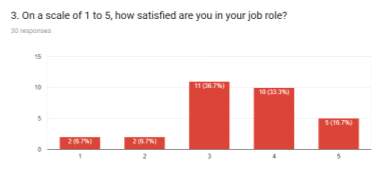
- Respondents were asked how satisfied they are in their job role. 5 being highly satisfied and 1 being highly dissatisfied.
- 16.7% of respondents are highly satisfied.
- 6.7% of respondents are highly dissatisfied.
- 36.7% of respondents chose 3 as their satisfaction rate. Implying that they are slightly satisfied with their job but there is room for improvement.
Question Four

- 93.3% of respondents said they believe that training and development opportunities are available to all employees. 6.7% said that they do not believe the opportunities are available to everyone.

- Respondents who answered no were given the chance to express why through an open-ended question.
- Both answers link to support from managers.
Question Five
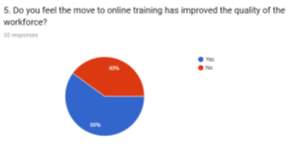
- 60% of respondents believe that the move to online training has improved the quality of the workforce.
- 40% believe that it has not.

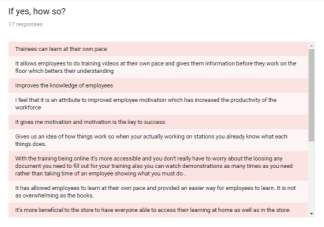
- If the respondent answered yes, they were asked for their opinion on why they believe this to be true.
- Many responses comment on the ease of access to information as well as the ability for employees to complete the videos at their own pace.
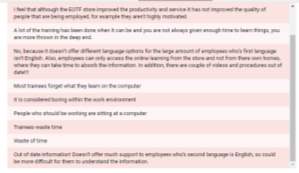
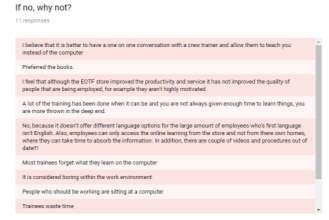
- Respondents who answered no were also given a chance to comment on why they felt this way.
- Many comments include it being boring, time consuming, there being too many videos as well as information being out of date and how it should be available in different languages to meet the diversity of the store.
Question Six

- 70% of participants feel that the training manager is not doing enough to support crew and help them through the training opportunities that are available to them.
- 30% believe that the training manager is doing enough.
Question Seven
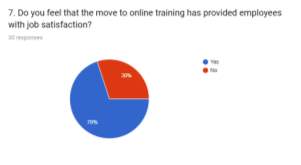
- 70% of respondents felt that the move to online training has improved job satisfaction.
- 30% believe it has not.
Question Eight

- There are mixed reviews on the rating of the system. The rating was based on 1 meaning the system needs to be updated and 5 being that the system does not need updating.
- 33.3% of respondents voted 3. Giving the system an average rating. This shows that the system is mainly seen to be adequate by employees.
- 16.7% of respondents said that the system needs to be updated.
- 10% believe it does not need to be updated.
Question Nine



- Respondents were asked on what improvements they felt needed to be made to the training system.
- A lot of the comments mention that it is a boring experience, an overload of information from the videos and that it should be accessible on other internet browsers than internet explorer.
- A few comments say that they feel the system is fine as it is and does not need updating.
Question Ten
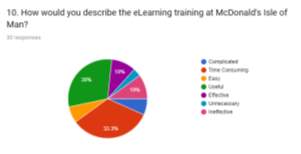
- The responses on this question seem to be quite mixed.
- 33.3% of respondents felt that the eLearning training was time consuming.
- 30% Felt that it is useful.
- 10% feel that it is effective with 10% finding it effective.
Question Eleven

- The responses to this question show that although 93.3% of respondents feel that the training opportunities are available to them. Only 30% of respondents are interested in being promoted.
- 70% of respondents do not want to move up the hierarchy.



- When asked what motivates them to get promoted the respondents gave mixed answers such as job satisfaction, opportunities, having a say in different matters and new experiences in their role.
- A lot of the responses to the question asking why they had said no included going to university, not feeling they are supported enough as well as comments on the current situations on shift.
Question Twelve

- 53.3% of respondents believe that managers are focusing on training and development enough.
- 46.7% of respondents believe that managers do not focus on training and development enough.
Question Thirteen

- 40% of respondents felt that positive recognition was most important to them.
- 36.7% felt that Training and Development was most important to them.
- 20% felt that financial reward was most important to them.
Question Fourteen

- 63.3% of respondents feel that managers give them enough support and advice throughout their training.
- 36.7% of respondents believe that they do not.

- 70% of respondents felt that the support given to them by managers increases their motivation.
- 30% of respondents felt that it decreased their motivation.
5.0 Analysis and interpretation of the findings
5.1 Introduction
This section will provide an in-depth analysis of the findings from the previous chapter to establish the effects that the current training and development is having on employee satisfaction, by considering the perceptions of employees using qualitative and quantitative data and comparing the results of my questionnaire with the one conducted by McDonald’s.
The sample of McDonald’s Isle of Man questionnaire was larger than the one conducted by the researcher however it will provide more analysis and understanding in relation to employee opinions.
5.2 Analysis of Findings
Question Three
This question asked respondents to rate their job satisfaction from 1-5. Participants in the questionnaire conducted by the researcher gave had 36.7% give their job satisfaction a rating of 3 and 33.3% give it a rating of 4. As well as 6.7% giving a rating of 1 out of 5. This shows that employees are adequately satisfied in their job role. There could be many explanations for this such as the current situation in the work place.
The five functional areas the are associated with effective HRM are; Staffing, Human Resource development, compensation and benefits, safety and health, and employee and labour relations. (Mondy and Noe, 2005).
Currently McDonald’s Isle of Man is experiencing a high employee turnover with a large amount of employees finding work elsewhere. This has had an impact on employees job satisfaction as there is more pressure on the current workers. Meaning that they have to work harder as well as help new employees.
This is illustrated in one of the responses to Question 11 where a respondent is asked why they do not want to move up in the hierarchy. “I like the thought of moving up but currently with the way shifts are running it’s not making me want to move up. I feel the managers need to be more positive and care about their staff and appreciate how the team pulls together on them hard shift.”.
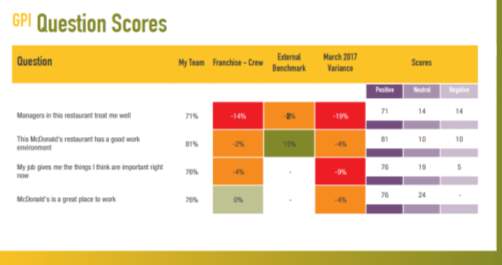
This is showing some of the stress an employee is facing at the minute, affecting the job satisfaction and motivation to use the training and development tools available to them. Furthermore, it shows the impact the low employee rate is having on the managers. Employees attitudes tend to be in response to the attitude of their superiors. (Mark Murphy.)
In comparison to McDonald’s Viewpoint Surveys results for October 2017. Employees were asked if they felt McDonald’s was a great place to work. With 76% of respondents giving positive feedback and 24% giving neutral feedback. Although this is almost 2 years ago, it shows a great difference in how employees felt at that time in comparison to now.
Feeling overworked is related to making more mistakes on the job, being angry with one’s employer and feeling resentful towards co-workers as well as feeling stressed and reporting more symptoms of depression. (Galinsky, 2005).
Question Four
Employees feel that the training and development opportunities provided to are accessible to everyone. This is good as it shows that McDonald’s Isle of Man are transparent in their approach towards promoting training and development. It allows employees to feel as though the option is there for them to take if they feel necessary.
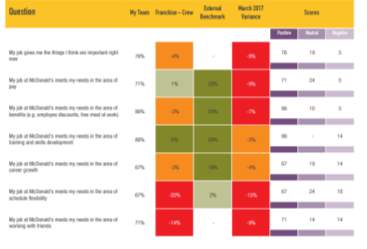
In the McDonald’s 2017 survey employees were asked if they felt that McDonald’s meets their needs in the area of training and skills and development. 86% of respondents believed that it does with 14% believing that it does not.
Furthermore, Employees were asked if their job at McDonald’s meets their needs in the area of career growth. 67% gave positive feedback with 19% providing neutral feedback and 14% providing negative feedback. Although in comparison to the external benchmark this is a good score, employees still gave negative feedback.
Understandably, the store can not meet the needs of everyone in the career growth aspect but this response may link to the 6.7% of participants from the researchers questionnaire that felt the training and development programmes at McDonald’s Isle of Man were not available to everyone.
(Llopis, 2013) proposed 5 fears employees have about their careers; Bad Boss, Ineffective Senior Leadership, No Mentors, Not reaching their full potential and Job Security. Reaching your full potential is impossible if your boss is not aware of or does not value the skill-sets and capabilities that you have to offer to the workplace environment.
This can reduce job satisfaction in employees as employees do not feel as though they are valued enough to make a career out of their employment in McDonald’s Isle of Man. However, there is a set of skills that the management team will be looking for in employees that have the potential to be promoted. For example, Hardworking, shows up to their scheduled shifts, motivates others and has the right attitude. If employees expect McDonald’s Isle of Man to invest their time and money into their training and development they must also consider the expectations of them by their employer.
This links back to the psychological contract and Iceberg model as mentioned in the literature review where work and pay are not just the main aspects of employment but the underlying expectations from both the employer and employee.
Question Five
The responses to question five show that respondents felt the move to online training had improved the quality of the workforce. With 60% answering yes to this question. The reasoning behind this is answered in a sub question where respondents who answered yes were able to give their opinion on why they thought that.
Many responses included the advantage that trainees are able to learn at their own pace. This means that the knowledge of employees can be improved and provide more job satisfaction as new starters at the store are scheduled a whole shift to complete their online training when they start. However, having the large number of videos online and being scheduled for an 8-hour shift to complete them may be overwhelming to new employees and it may affect their learning capability as they are sitting in front of a computer all day.
Also, one of the main negative points about the online learning is that it is not available in different languages. McDonald’s is a diverse multi-cultural organisation that has many employees who do not have English as their first spoken language. Only offering the eLearning videos in English does not suit the needs of all employees and it will mean that the videos take longer to complete. It is especially difficult to schedule someone to aid in the completion of the videos as well which makes the situation even more difficult. This costs the business more time and money.
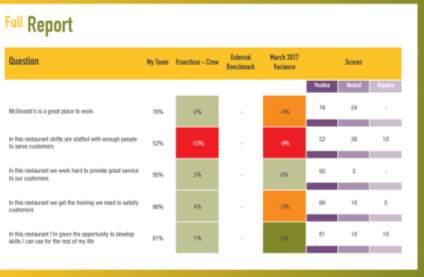
Within the 2017 McDonald’s viewpoint survey, employees were asked if in this restaurant they get the training needed to satisfy customers. 86% responded with positive feedback with 10% having neutral comments and 5% having negative. This clarifies that employees feel that the training is there for them but there are still some employees who feel that they do not think the trying meets the needs of customer service.
The satisfaction of customers is necessary for a successful organisation but the value for employee satisfaction is there to achieve the vision and mission. (BANKER, 2000). This is important to remember for employers as if the employees feel valued and looked after by the organisation then the customers will feel satisfied as they will receive a great service every time.
Question Six
This question was regarding the support of the training manager. 70% felt that the training manager did not support crew enough in order to promote the use of the training facilities available. This shows that the training manager is not heavily involved enough in the promotion of employees even though they are in charge of deciding who does or does not get promoted.

This links to employee satisfaction as the training manager can easily miss someone who is working hard and suitable for promotion but does not get enough recognition for their work because they do not stand out.
One of the opportunity questions flagged by the McDonald’s Viewpoint survey was asking employees if they felt that managers in this restaurant showed that they care about the employees. This received 48% positive feedback with 33% neutral feedback and 19% negative feedback. This was below the external benchmark by 25% and was identified as one of the highest opportunities for the team.
This has an impact on employee satisfaction as employees look for constant recognition to know that they are doing well. Whether this be through financial reward, or their manager recognising they have done a good job and saying thank you to them for their hard work. Having recognition could also help the training manager aid in getting the right people promoted and making sure everyone with potential is being recognised.
Feedback is a critical component of all performance management systems. Performance feedback can be defined as information about employee’s past behaviours with respect to established standards of employee behaviours and results. The goals of performance feedback are to improve individual and team performance, as well as employee engagement, motivation and job satisfaction. (Aguinis, 2009).
This also links to question 13 of the questionnaire conducted by the researcher where respondents were asked what is most important to them as an employee. 40% answered with positive recognition and 36.7% answered with training and development. Showing that these are of high importance to employees of McDonald’s Isle of Man and should be thought about by the training manager who is aiming to support the crew.
Question Seven
Competitive workforce and business practices have evolved to reflect economic competitiveness in developing and retaining talented employees. Organisations are continually seeking new solutions to assess employee development. (Hassan, 2018).
70% of respondents felt that the move to online training provided employees with job satisfaction. This shows that employees are relating training and development with job satisfaction.

The McDonald’s 2017 questionnaire asked employees whether their job at McDonald’s gives them things they think are important right now. 76% answered positively. This shows that employees have a positive view of the organisation and that they believe the business does treat them well but there are some areas that could be improved.
6.0 Conclusions
From the analysis of the findings in comparison to the findings of the Employee Viewpoint Survey and in relation to employee job satisfaction at McDonald’s Isle of Man it may be argued that employees have decreased in job satisfaction in comparison to how they felt in 2017.
There are also other factors affecting employee satisfaction at the moment as expressed in the open-ended questions and it seems like training and development is the least of people’s problems. The lack of employees within the store has led to increased stress for employees as they have to work harder and longer shifts. Meaning that they are going into work and being valued at more than what they are being paid for.
However, if the move to online training is to be looked at solely as an argument for increased job satisfaction it can be argued that it has impacted the store greatly with employees feeling as though the opportunities are there for them to take if they feel like it. Although, many employees are staying in the same positions due to them not wanting anymore stress being put onto them.
Furthermore, what is most important to employees was outlined as training and development as well as positive recognition for their work. All of which contribute to employee satisfaction.
In relation to the hypothesis that employee morale, motivation and performance have improved dramatically over recent years since new training systems have been put in place. It can be argued that this hypothesis is disproved as the findings show a trend of people not being content with their job role and not feeling fully supported by managers. When this is also compared to the results of McDonald’s own questionnaire from 2017 which although was conducted on a larger sample size; has better results than the dissertation questionnaire linking to a decrease in employee satisfaction.
Although, the research has been useful in identifying the other factors affecting employees and generating valued opinions that gave an insight into how employees truly feel.
In regard to the eLearning system, many respondents argued that they preferred the books and the eLearning videos were overwhelming as there is so many of them. As well as the system not being available on many internet browsers. Furthermore, the system needs an upgrade which should include different language options as well as videos that match the new style of store.
The questionnaire had a mix of good and bad responses. Many employees seem to really enjoy their job at McDonald’s and believe that the move to online training has resulted in improved employee satisfaction. However, employees also feel that the system is outdated and needs an upgrade. Many comments in the questionnaire were linked to the running of shifts at the minute and managers not supporting employees enough. Although, there was a large amount of positive feedback that believed the training was beneficial to new employees.
It is quite confusing to see the responses of the questionnaire as many respondents seem to be content with their job role but do not want to be promoted. Many participants wrote that they are happy where they are although many of them put training and development as one of the most important aspects of their role.
6.1 Critical Evaluation of Adopted Methodology
Due to the rigid nature of the methodological type, the researcher was unable to account for external factors affecting employee satisfaction. Such as scheduling, recognition from managers and financial reward offered by the business; until a very late stage in the research.
It was also difficult to meet all objectives written in the dissertation proposal due to an analysis being conducted of two surveys. The researcher was unable to look in depth at the objectives set by McDonald’s Isle of Man in regard to training and development for comparison over the previous years due to too much workload already being occupied.
The questionnaire was more time consuming than anticipated which made the analysis harder to do as it needed to be done quickly. However, the questionnaire did provide information that would not have been included in other types of research.
6.2 Limitations
The time allocated to analyse the results of the questionnaire was greatly impacted by responses to the questionnaire getting in extremely late. Meaning that analysis could not be done as in depth as the researcher would like. Due to time restrictions the researcher was also not able to meet all objectives set out in the research proposal. However, this did not affect the outcome of the work and the validity of the results.
A fear of the validity of results was a limitation as although the questionnaire was fully anonymous employees may still have felt that the questionnaire would have an impact on their job. Or that the business manager may see the results of the questionnaire and want to know who wrote the answers. Resulting in employees not wanting to give their honest answer.
6.3 Opportunities for further research
The research has been effective in finding out how employees feel about the training and development opportunities given to them. However, the response was largely from crew members. This shows that there are opportunities for more research in regards to the manager perspective and how they perceive the current situation.
It would be interesting to discover how managers feel the training and development system is being implemented as well as how they feel the crew members are taking on opportunities. Although managers were on option on the questionnaire not many of them were asked for a response as the researcher felt that crew members view was more suited to the investigation as well as not having the chance to ask many managers to respond.
Furthermore, If the researcher was to do the dissertation again, they would look at more years of the McDonald’s viewpoint survey and discuss what changes can be seen in the questionnaire responses as well as analysing more data. The questionnaire conducted by the researcher would also be directed at one group of employees rather than all of them so that the work submitted was a true representation of the organisations beliefs and values from the group of employees.
6.4 Recommendations
- An updated training plan should be made with the training manager to improve employee engagement and result in more people wanting to be promoted.
- This will benefit the store as employees will feel more valued and as though the training manager cares about them.
- Focus on positive feedback mechanisms for employees ensuring that they are getting the feedback that is deserved.
- This will improve employee satisfaction and promote the use of the training facilities available even further.
- Update the current training system software to be used on different internet browsers.
- This may reduce complaints that the training is bad quality and may reduce the time it takes to complete the videos.
- Offer the training facilities in different languages to help meet the needs of all employees.
- This will help provide the required and extra knowledge to all employees and ensure that they all understand it rather than people giving them the answers.
- Review how employee objectives are lined with the businesses.
- Employees having knowledge on this will benefit the store as they can see how their success is positively contributing to the store.
- Employees should also be made aware of any training objectives that the business has, this will give them something to work towards and a sense of accomplishment when they have been achieved.
- The viewpoint survey for 2019 should include more questions about how employees feel about online training so that head office has an understanding of what employees think of the system.
- This will allow for changes to be made to the system that could be out of McDonald’s Isle of Man resulting in great improvements to employee knowledge as well as further job satisfaction.
References
Aguinis, H. (2009). Performance Management . Upper Saddle River, NJ: Pearson Prentice Hall.
Ahmed, Y. A., Steel, A. C., & Soar, J. (2016). Determinants of perceived usefulness of eLearning systems. Computers in Human Behavious, 3.
Ali, J. (2018, January 24). 9 Advantages of online training . Retrieved from eLearning Industry: https://elearningindustry.com/advantages-of-online-training-9
Armstrong, M. B. (2018). International journal of training and development. Gamification of employee training and development.
BANKER, R. D. (2000). A contextual study of links between employee satisfaction, employee turnover, customer satisfaction and financial performance. , University of Texas at Dallas.
Biars, L. (2005). Virtual learning: e-learning–or computer-based training–has proven to be very effective in fast-paced organizations that need to share knowledge quickly and efficiently. Food and Drink.
CIPD. (2019, February 12). The psychological contract. Retrieved from CIPD: https://www.cipd.co.uk/knowledge/fundamentals/relations/employees/psychological-factsheet
Costen, W., & Salazar, J. (2011). The impact of Training and Development on Employee Job satisfaction, loyalty and intent to stay in the lodging industry . Journal of Human Resources in Hospitality and Tourism.
Davis, B. (2013). Food and Beverage Management . Routledge Ltd- M.U.A.
Dentzel, Z. (2018). How the internet has changed everyday life. Spain: CEO, Tuenti .
DiPietro, R. B., & Thozhur, S. M. (2007). Hourly employee retention factor in the United Kingdom quick service restaurant industry. Journal of Foodservice Business Research.
European, C. (2018, December 10). e-learning. Retrieved from International Cooperation and Development: https://ec.europa.eu/europeaid/tags/e-learning_en
Fletcher, J. (2004). The Strengths and Difficulties Questionnaire overseas: Evaluations and applications of the SDQ beyond Europe. European Child & Adolescent Psychiatry, 1.
Galinsky, E. (2005). When the way we work becomes too much. New York: Families and Work institute .
Garrow, V. (2004). Training and development and the psychological contract. Training Journal, suppl. focus on psychology at work.
Gomes, J. &. (2014). Organizational Maturity and Projects Performance: The Mediation of Benefits Management. Proceedings of the 10th International Conference on Web Information Systems and Technologies., 2.
Hall, E. T. (1977). Beyond Culture . Chicago: Anchor Books.
Hassan, A. (2018). The Effect of Training on Job Satisfaction: A Review Paper. The International Conference of Social Sciences and Humanities 2018.
Hussey. (1985). Implementing corporate straegy: Using management education and training . Long Range Planning.
IRMA. (2018). Teacher Training and Professional Development . Hershey, PA`: IGI Global.
Karagonlar, G., Eisenberger, R., & Aselage, J. (2015). Reciprocation wary employees discount psychological contract fulfillment. Journal of organisational behaviour.
Khawaja, F. L. (2012). An integratd model of training and effectiveness and satisfaction with employee development interventions. Guilsborough.
Llopis, G. (2013, October 21). 5 Fears Employees Have About Their Careers. Retrieved from Forbes: https://www.forbes.com/sites/glennllopis/2013/10/21/5-fears-employees-have-about-their-careers/#5e66dda96e8b
Mack, L. (2018). The philosophical underpinnings of educational research. The philosophical underpinnings of educational research, 1.
Masrom, M. (2007). Teachers Perceptions and Needs towards the Use ofE-Learning in Teaching of Physics at Secondary Level. Technology Acceptance Model and E-learning.
McLeod, S. (2019). Sampling Methods. Retrieved from Simply Psychology: https://www.simplypsychology.org/sampling.html
Montanez, R. (2018, September 9). Three ways to keep employees engaged. Retrieved from Forbes: https://www.forbes.com/sites/rachelmontanez/2018/09/09/how-to-keep-employees-engaged-according-to-nationwide-findings/#1147197da450
Moulin. (2007). Performance measurement definitions . Guest Editorial, 1-2.
Nadolny, A., & Ryan, S. (2015). McUniversities revisited: a comparison of university and McDonald’s casual employee experiences in Australia. Studies in higher education.
Purba, H. H. (2017). Employee satisfaction analysis with human resource index. Management science letters, 1.
Raziqa, A. (2014). Impact of Working Environment on Job Satisfaction. BUSINESS, ECONOMICS, MANAGEMENT and TOURISM.
Ritzer, G. (2014). The McDonaldisation of society. Sage Pubns; 8th edition.
Saunders, M., Lewis, P., & Thornhill, A. (2012). Research Methods for Business Students. London: Pearson Education Limited.
Saunders, M., Lewis, P., & Thornhill, A. (2016). Research Methods for Business Students. Essex: Pearson Education Limited.
Silva, P. (2006). Effects of disposition on hospitality employee job satisfaction and commitment . International journal of contemporary hospitality management , 317-328.
Smith, A., & Erica, S. (2007). The role of training in the development of human resource management in Australian organisations. . Human Resource Development International;, 2.
Speer, J. D. (2017). Pre-market Skills, Occupational Choice, and Career Progression . The Journal of human resources.
Thomson. (1998). Management by objectives. Jossey-Bass/Pfeiffer .
Times, E. (2015, August 31). Importance of training and development in an organisation. Retrieved from Economic Times: https://economictimes.indiatimes.com/small-biz/hr-leadership/people/importance-of-training-and-development-in-an-organization/articleshow/48739569.cms?from=mdr
Toyota. (2013, May 31). Kaizen- Toyota Production System guide. Retrieved from Toyota blog: https://blog.toyota.co.uk/kaizen-toyota-production-system
Zhang, X., & Yuhao, L. (2012). Knowledge Building in E-Learning.
Appendices
Questionnaire

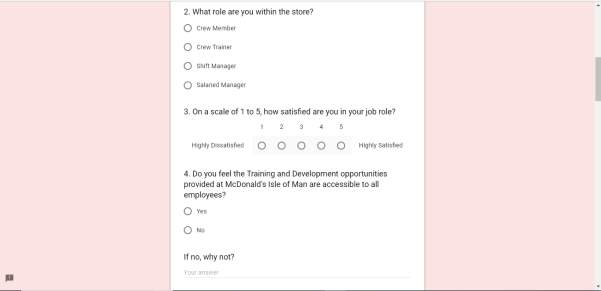
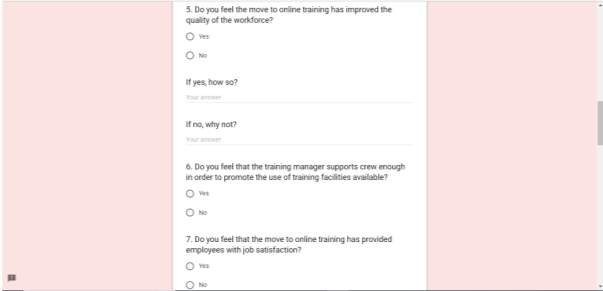




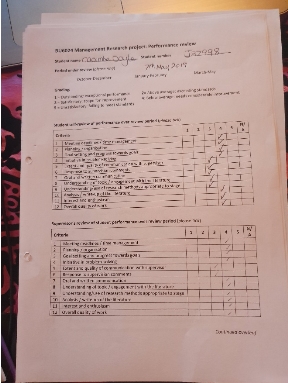

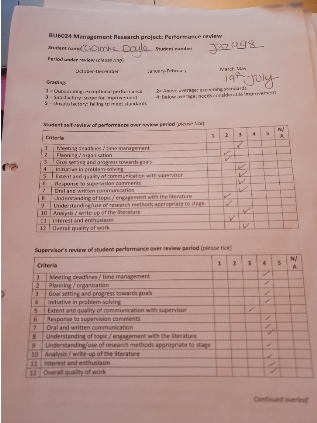
Performance Reviews

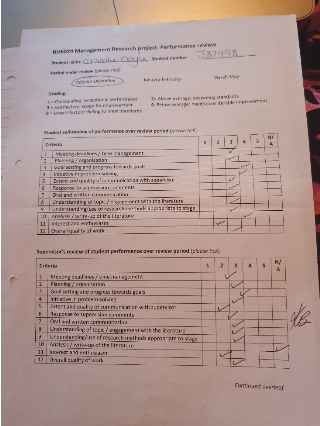


Ethics Approval Form

Approval of use of McDonald’s in Research Project



Cite This Work
To export a reference to this article please select a referencing stye below:
Related Services
View allRelated Content
All TagsContent relating to: "Employment"
Employment is the state of being employed, or being paid to work for an organization or person. Employment studies could cover various related topics including occupational health and safety, discrimination, pensions, and employment law.
Related Articles
DMCA / Removal Request
If you are the original writer of this dissertation and no longer wish to have your work published on the UKDiss.com website then please:




